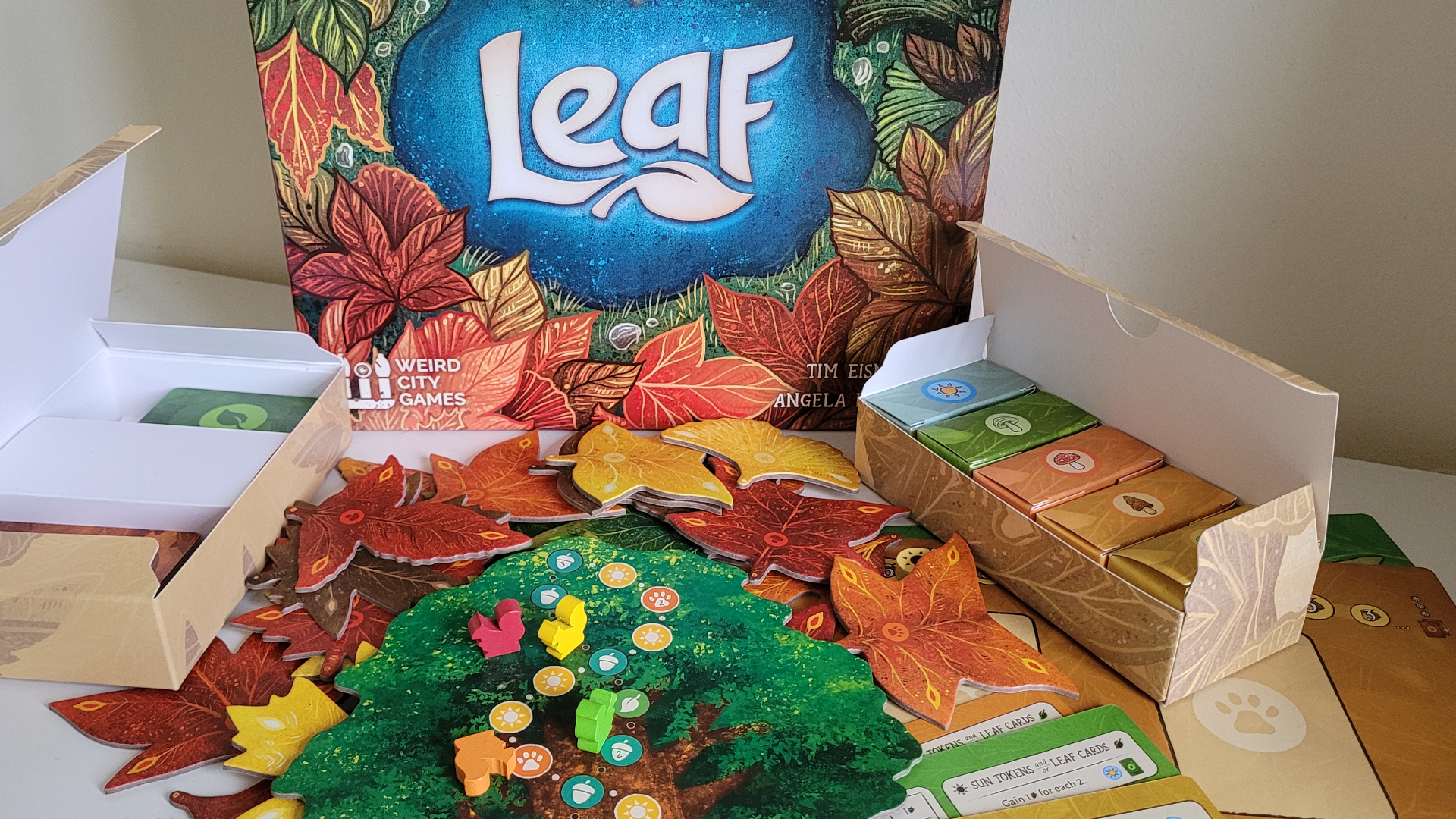GamesRadar+ Verdict
Leaf is an easy-going and accessible family board game, but this isn't something you'll forget as soon as it's packed away; its core mechanics (touching leaf tips together to gain actions) are surprisingly novel. While there's not quite enough depth to be playing this one over and over again, its streamlined approach makes it ideal for families.
Pros
- +
Novel tile-tip mechanic feels fresh and engaging
- +
A great introduction to modern multi-paths-to-victory games
- +
Accessible rules, pretty components, and inviting theme give this wide appeal
Cons
- -
Too lightweight for sustained interest, especially for seasoned gamers
- -
Usability issues, with too many similar colours and fragile tile patterns
Why you can trust GamesRadar+
Leaf is the sort of board game that takes a daydream and runs with it.
Who among us has not, at one point or another, wondered what it might be like to be the very spirit of the wind itself, whispering through the autumnal forest that it’s time for leaves to fall and animals to hibernate. No? Well, you’ve got to admit that it’s a pretty appealing concept either way. Now you get the chance to take that scenario out of your imagination and onto the tabletop with novel tile-laying game Leaf.
Leaf: Features & design
| Price | $40 / £40 |
| Ages | 8+ |
| Players | 1 - 4 |
| Genre | Tile-laying |
| Complexity | Low |
| Lasts | 45mins |
| Play if you like | Carcassonne, Everdell, crisp Fall days |
- You touch the tips of irregularly-shaped leaf tiles together, gaining actions depending on adjoining leaves
- Different actions feed into different sources of victory points
- Players decide when to advance turns by spending sun tokens for extra points
Like a lot of family board games, Leaf is a pretty straightforward, and you can take a few practice rounds to help people get the hang of it if necessary. Play revolves around placing leaf tiles onto the table, connecting at clearly-marked tips. There are six different shapes of leaf, with differing amounts of tips. You can’t just choose any leaf to add to the growing patterns, however. Rather, you have a hand of leaf cards, and you play one to take a matching shape from the pile.
When you place a leaf, each point it touches grants you an action, depending on the colour of the touched tile. Green ones give you more leaf cards. Brown leaves allow you to take animal cards, which are worth points at game end for each set of leaves that point belongs to. Green leaves let you take additional leaf cards. Yellow leaf actions gain you sun tokens, which you can spend to advance the game turn and gain some points. Brown leaf actions involve moving your token up a tree board, which has various branching tracks that gain you various rewards. Orange leaves, on the other hand, allow you to pick up animal cards from a face-up selection.
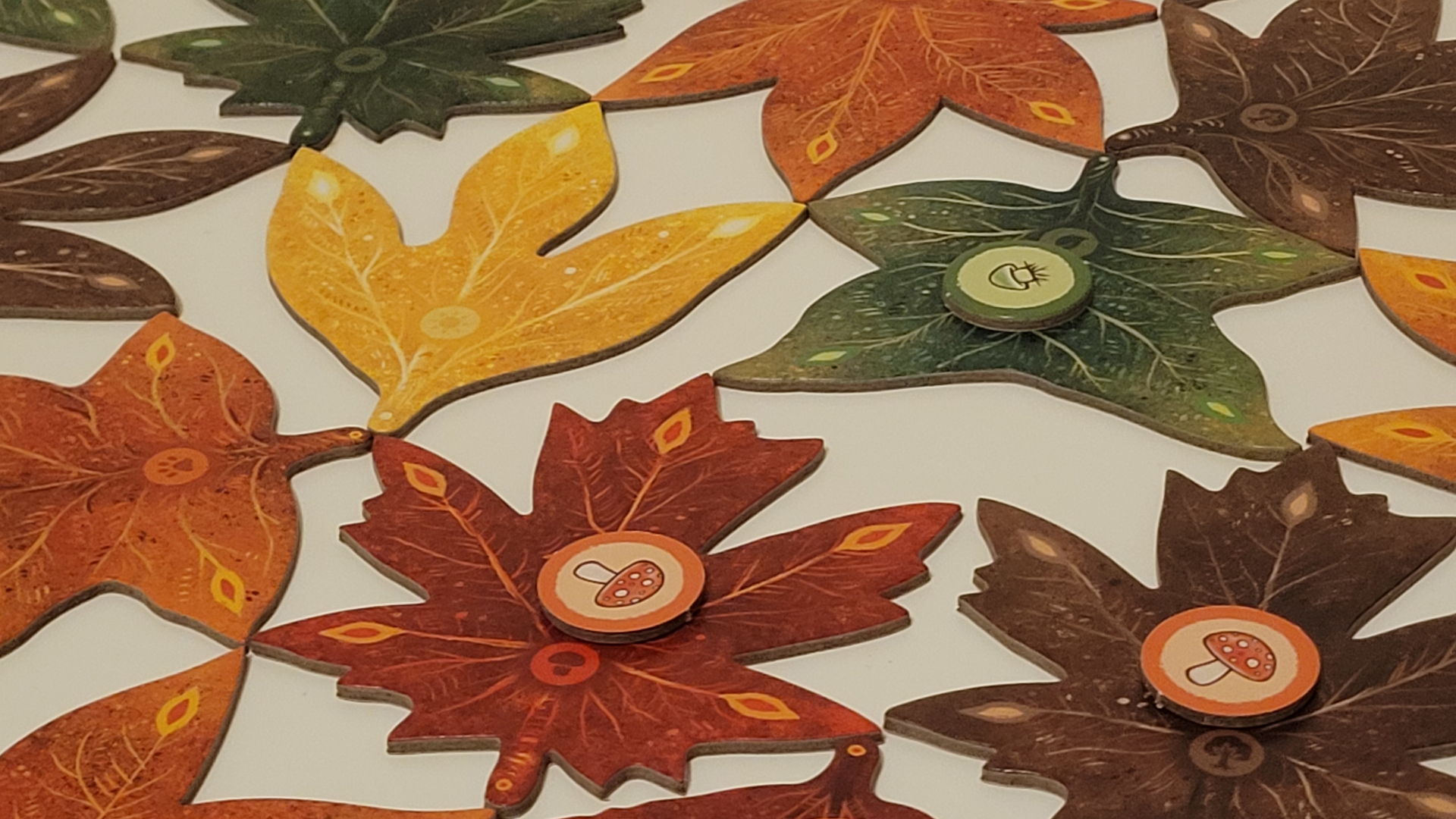
Speaking of which, you can “hibernate” groups of matching animal cards on some turns, and they’ll gain you points depending on the group size.
The most complex action involves growing mushrooms, which is provided by red leaves, although you can also place a mushroom by playing two matching leaf cards when you start your turn. Each player has their own colour of mushroom, and the little fun guys start out as baby counters that you place on leaves. Future actions can be used to grow these babies into adult, fruiting toadstools. Your goal is to create groups of grown mushrooms on adjacent leaves, as each such group will score you points depending on its size at game end.
That’s pretty much the entire rules of the game, making it relatively easy to teach, although the way in which advancing turns is down to player control rather than happening automatically may be unfamiliar. Each player gets a mat to separate collected animal cards from hibernating ones, which is printed with a helpful summary of the scoring rules on one side and the actions on the other, making it easy to remind everyone of how things work.
Carved wooden squirrel pieces to track your progress up the tree are a nice touch
Component-wise, Leaf has a lot of the standard sprues of punch-out cardboard you’d expect from a tile-laying game of this type. But the carved wooden squirrel pieces to track your progress up the tree are a nice touch, as are the tuckboxes supplied to keep your components neatly organised.
On the other hand, while the palette of red, brown and orange on the components is very fitting for the theme, it can make some of the leaves and player colours difficult to tell apart, especially in the low light of an autumnal evening. The pattern of touching leaves is also incredibly easy to disrupt with even a gentle nudge.
Leaf: Gameplay
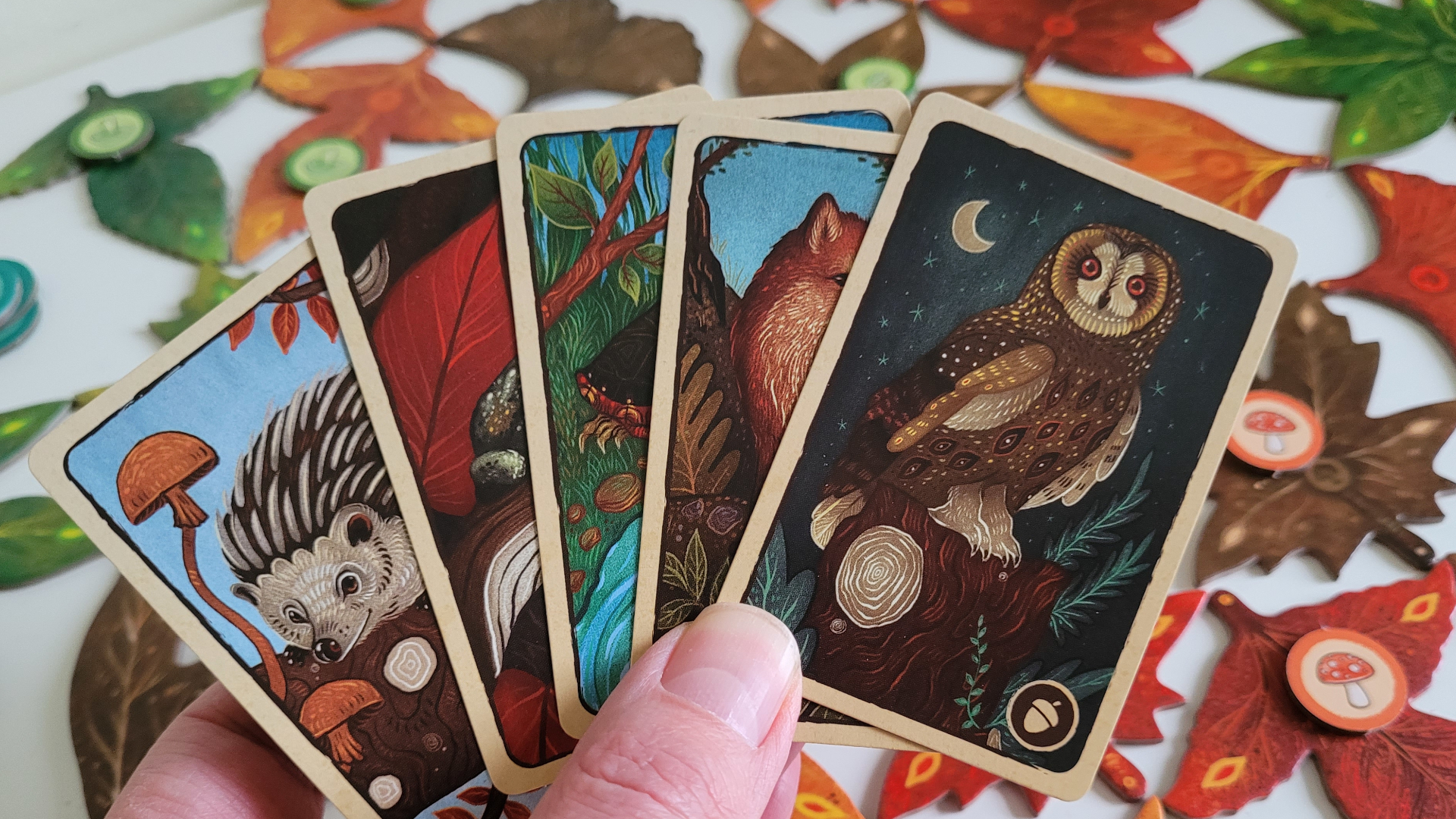
- Tip-based tile laying is novel and creates a consistently interesting puzzle
- Balancing ways to get points keeps you engaged, but some are more important than others
- Lightweight nature makes it accessible, but it can get repetitive quickly
Veterans of other tile-laying games will immediately be struck by how novel and fun Leaf’s tip-touching mechanic is. No longer is choosing and placing a tile solely informed by the tired, regular geometries of squares and hexagons. Your choice is now a combination of the cards in your hand, the number of tips each of those different shapes might touch, the actions you’ll get for doing so, and the potential opportunities you might create or close off for future leaf-layers. It’s an astonishing amalgamation of different elements for such a simple concept to achieve.
There are downsides: for one, most players are going to find it hard to figure out how different leaf shapes might fit into the pattern simply by looking. Instead, it’s a matter of pulling them off the pile and trying them out for size in the very fragile interlacing of leaves the game so far has created. But while that can be a pain, the very act of trying to figure out how to maximise your touching tips is a fine indicator of just how many interesting variables this game gives you to juggle.
For games with younger or less hardcore players, that lighter level of accessibility can be an actual boon
Its next layer of decision-making is trying to figure out just what actions will get you what you need. At this level, the game is slightly more simplistic than it aspires to be. When you need leaf cards, you need leaf cards. As regards other sources of points, the two biggest ones are collecting sets of mushrooms and animals. And in both those cases, decisions are likewise obvious as you try to grow your biggest groups. Moving your squirrel up the tree, in particular, feels a little tacked-on despite an end-game bonus for the highest rodent at the end of the game; it feels like an excuse just to add in those cute wooden squirrel meeples.
Sun tokens, however, shouldn’t be overlooked. Putting the end of each turn in control of the players is a fascinating design choice that pays off well after its initial unfamiliarity. The person who pushes the little sun disc forward on the track earns a decent pot of points for their trouble. More interestingly, they also get to decide when players are allowed to hibernate a group of animals. When you recall that only hibernated animal groups score points, and that you get more points for bigger groups, this can be a fun way to stymie other player’s plans. Or, indeed, to diversify your own decision-making if you want control of the seasons in order to hibernate your own critter collection.
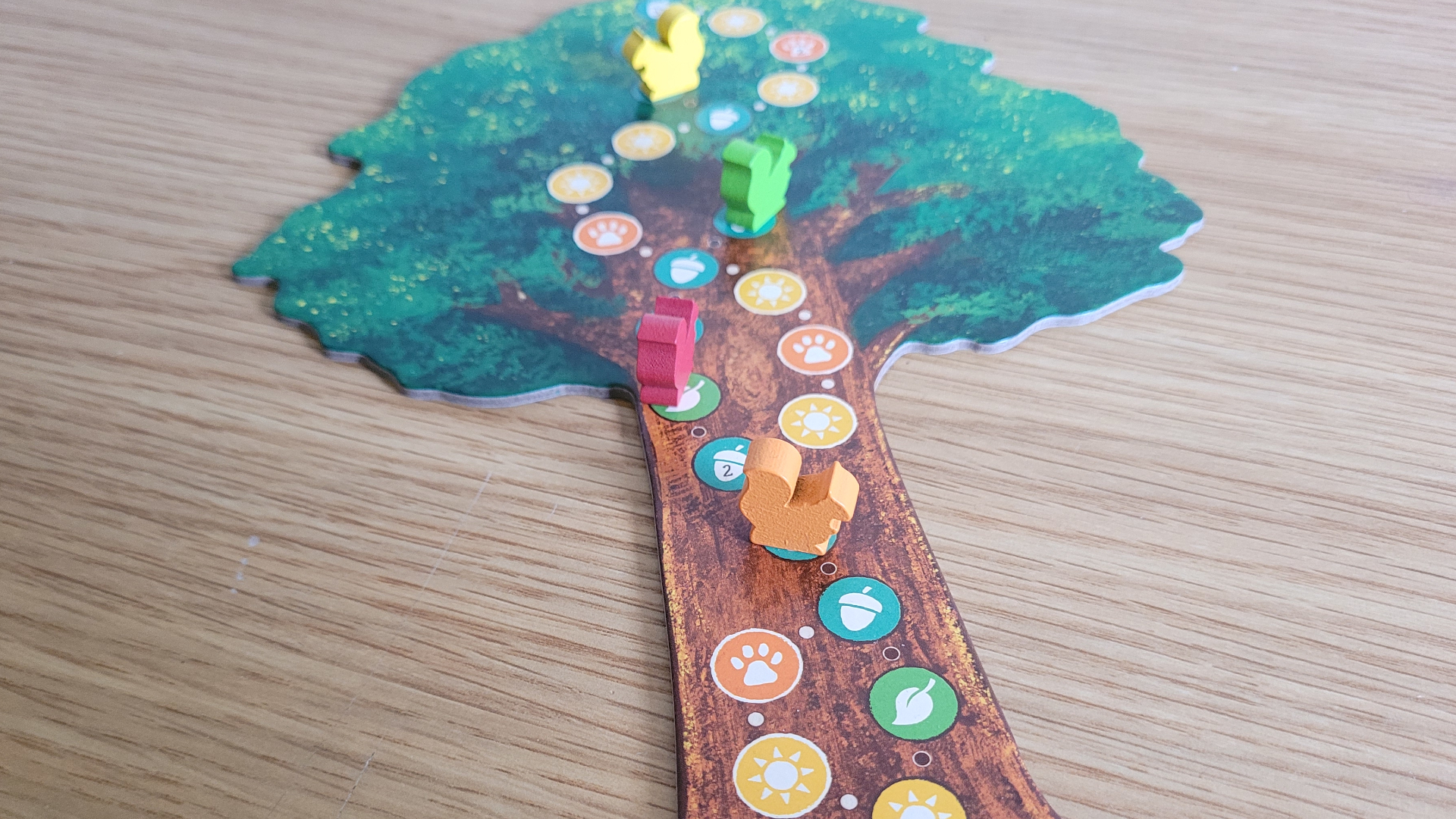
That is about the only meaningful source of interaction that the game offers, though. It’s very much a heads-down affair, where you’re almost wholly preoccupied with your own tableau of cards and mushrooms. Each player can have a mushroom on each leaf, so there’s not even any scope for blocking or spatial manoeuvre. Of course, if you’re looking for relatively harmonious family play with a small sting in the tail when you tot up the points and someone has to take the victory, that might not be a problem.
A bigger issue with the game is that while its central twist of leaf-joining is novel enough to remain fun over repeat games, the rest of the choices on offer don’t support long-term play. Hardened gamers, in particular, may tire of it quite quickly once they discover there’s not a whole lot underneath the leaf litter. But, again, for games with younger or less hardcore players, that lighter level of accessibility can be an actual boon. And if you really want to squeeze maximum replay value out of Leaf, there’s a solo option with a list of challenges to tick off, which will take you a while to work through.
Should you buy Leaf?
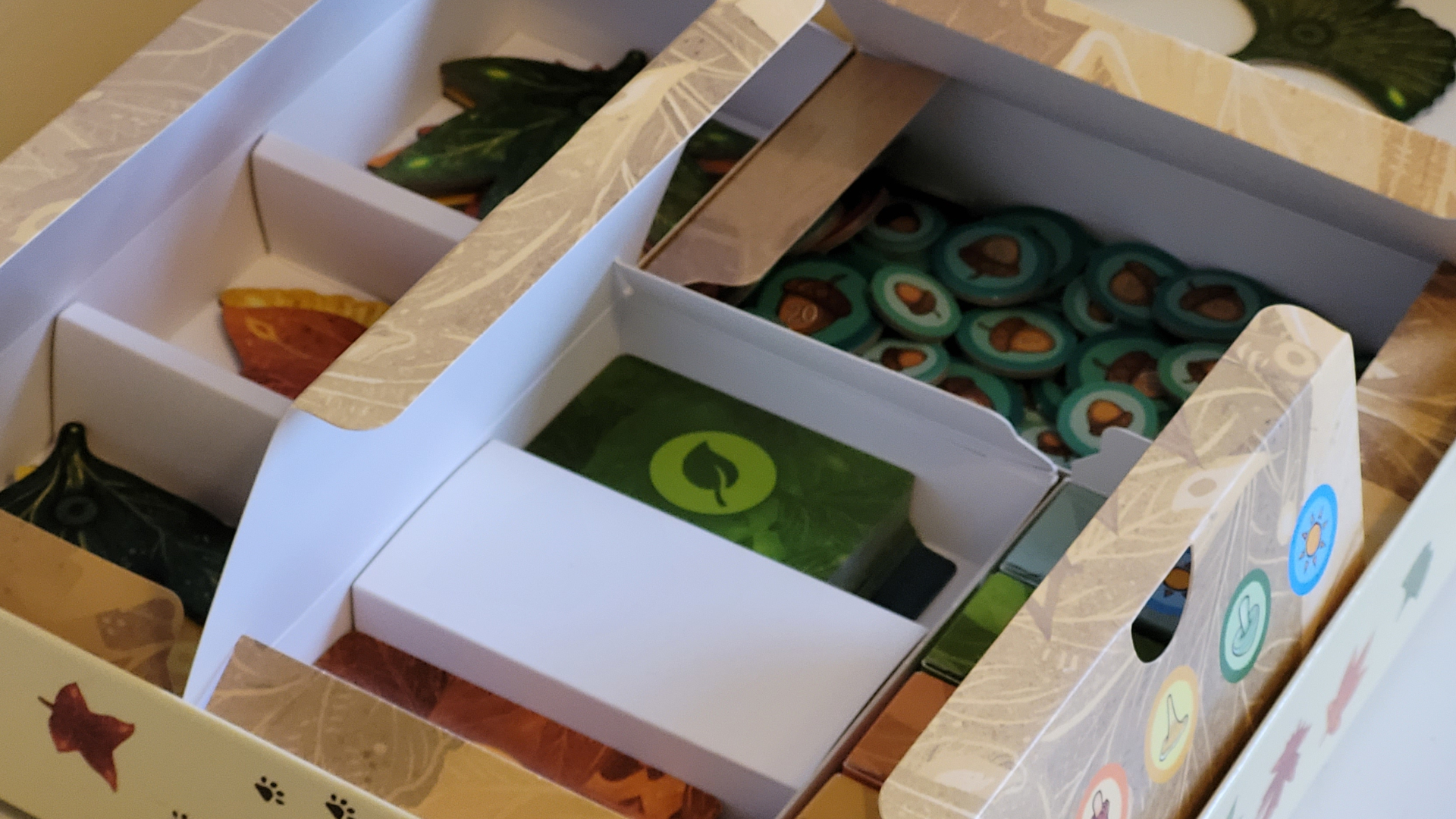
Between its accessible rules and attractive components, Leaf is a game with wide appeal. While it feels squarely aimed at autumnal family evenings with the nights drawing in toward winter, it’s easy to learn and fun to play any time of the year. But what really elevates it is that novel tip-touching mechanic, which is easily interesting enough to merit the attention of hobby gamers too, despite a few problems the game has with longevity and practicality.
So, unless you’ve the Fall equivalent of a Grinch, harrumphing at the bonfire of the trees and the busyness of the beasts, there’s certainly something to engage you here, if only for a little while.
Buy it if...
✅ You're looking for a family game
If you’re in the market for a lightweight family game with a cute theme, this will hit the spot.
✅ You want something unique
Those interested in novel board game mechanics in general should find a lot to love here.
Don't buy it if...
❌ You want something deep
Anyone that prefers heavier or more complex games with lots of replay value may end up disappointed with Leaf.
❌ You’re easily annoyed by usability issues in games
All of those similar colors for tokens and components can be a pain to distinguish between.
How we tested Leaf
As with all review products on GamesRadar+, we played this board game multiple times to get a feel for its gameplay, longevity, and accessibility. You can find out more in our review policy, not to mention this guide on how we test board games.
Disclaimer
This review sample was provided by the publisher.
More info
| Genre | Strategy |
Matt is a freelance writer specialising in board games and tabletop. With over a decade of reviews under his belt, he has racked up credits including IGN, Dicebreaker, T3, and The Guardian.
